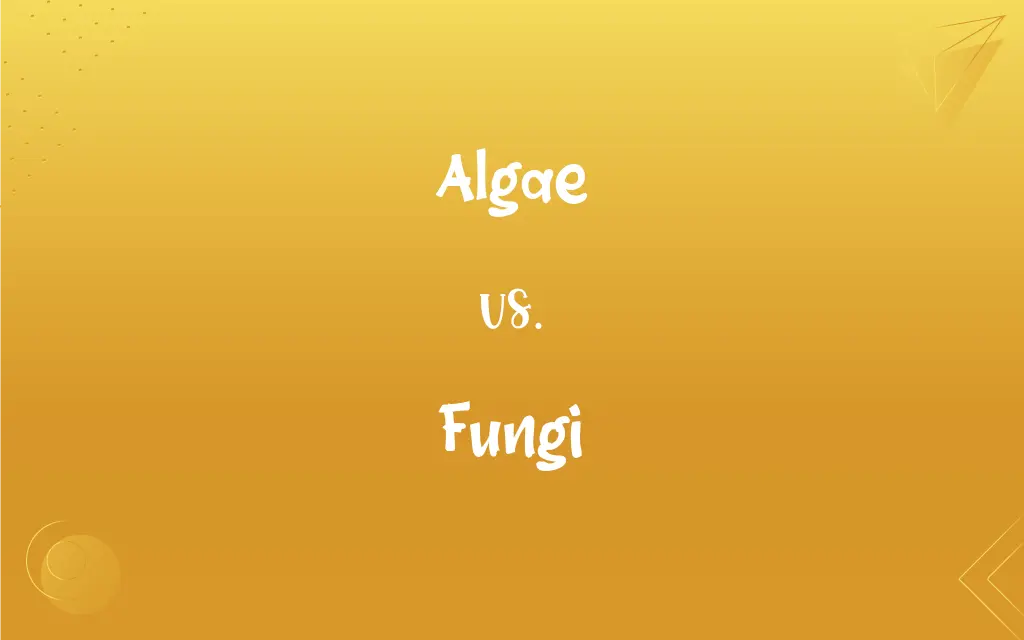Algae vs. Fungi: What's the Difference?
Edited by Aimie Carlson || By Harlon Moss || Updated on October 7, 2023
Algae are simple, autotrophic organisms that can perform photosynthesis, while fungi are complex, heterotrophic organisms that obtain nutrients through absorption.

Key Differences
Algae and fungi inhabit distinct biological kingdoms due to their fundamental differences. Algae typically belong to the kingdom Protista or Plantae, depending on the classification system. Fungi anchor themselves solidly into the Fungi kingdom, characterized by their unique cellular structures and reproductive mechanisms. Algae are primarily autotrophic, meaning they produce their own food through photosynthesis, using sunlight, water, and carbon dioxide. In stark contrast, fungi are predominantly heterotrophic, deriving nutrition by absorbing nutrients from other organisms, often breaking down decaying matter or forming parasitic or symbiotic relationships with other organisms.
Algae and fungi exhibit stark differences in their cellular organization and structures. Algae generally contain chlorophyll, which allows them to carry out photosynthesis, converting sunlight into energy and often contributing significantly to oxygen production. Fungi lack chlorophyll and thus do not engage in photosynthesis; their cells are often characterized by rigid cell walls made of chitin, which supports their structures and defines their forms. Algae predominantly exist in moist environments or aquatic settings, such as oceans, lakes, and ponds, where they can access ample light for photosynthesis. Fungi, while also favoring moist environments, can be found in a broader range of habitats, such as soil, decaying matter, and as symbionts with plants, animals, or other fungi.
Algae and fungi present distinctive reproductive strategies and life cycles that further differentiate them. Algae may reproduce through a variety of methods, which include binary fission (asexual), fragmentation, spore formation, and sexual reproduction, often adapting their strategy to environmental conditions. Fungi, on the other hand, reproduce both sexually and asexually via the production of spores, which can be spread through air, water, or organisms to colonize new environments. The variety and complexity of reproductive methods in fungi are vast, with some species capable of producing multiple types of spores depending on environmental conditions.
Algae can be unicellular or multicellular, and they often form colonies or filaments. Their cellular structures can be quite simple, as seen in unicellular algae, or complex, as in multicellular species. Fungi, however, are mostly multicellular, with bodies (mycelia) made up of a network of filaments (hyphae) that permeate the substrate they inhabit. The structural complexity of fungi enables them to effectively break down and absorb nutrients from their surroundings, playing a pivotal role in nutrient cycling within ecosystems.
Interestingly, algae and fungi can also establish symbiotic relationships with each other, creating lichen. In lichen, algae or cyanobacteria (a type of photosynthetic bacteria) form a partnership with fungi, where the algae provide nutrients through photosynthesis, and the fungi offer a protective environment and additional nutrients. This relationship typifies the intricate interdependencies that can develop between different organisms, embodying a tangible intersection between the diverse worlds of algae and fungi.
ADVERTISEMENT
Comparison Chart
Nutrition
Autotrophic (create own food)
Heterotrophic (absorb nutrients)
Cell Wall
Composed mainly of cellulose
Composed of chitin
Habitat
Mostly aquatic environments
Diverse environments
Structure
Simpler structures
More complex structures
Algae and Fungi Definitions
Algae
Algae produce a significant amount of Earth’s oxygen through photosynthesis.
Algae play a crucial role in our planet's oxygen supply.
ADVERTISEMENT
Fungi
Fungi are spore-producing organisms that feed by absorbing nutrients.
The fungi silently decomposed the fallen log over several years.
Algae
Algae are photosynthetic, usually aquatic, simple organisms.
The pond was covered in a thick layer of green algae.
Fungi
Fungi can be unicellular (yeasts) or multicellular (mushrooms, molds).
While mushrooms are visible to the eye, some fungi, like yeasts, are microscopic.
Algae
Algae can be found in various environments, including freshwater, seawater, and moist rocks.
Algae not only thrive in oceans but also in freshwater lakes.
Fungi
Fungi play a crucial role in decomposition and nutrient cycling.
Fungi decompose dead organisms, recycling their nutrients back into the ecosystem.
Algae
Algae serve as a vital component of aquatic food chains.
Many aquatic organisms depend on algae as their primary food source.
Fungi
Fungi can form mutualistic relationships, such as mycorrhizal associations with plants.
Mycorrhizal fungi assist plants by expanding their nutrient absorption capacity.
Algae
Algae can be unicellular or form complex multicellular structures.
Some algae live in colonies that can be seen without a microscope.
Fungi
Fungi possess cell walls made of chitin instead of cellulose.
The cell walls of fungi are tough due to the presence of chitin.
Algae
Any of numerous photosynthetic organisms of aquatic or moist habitats, ranging in size from single-celled diatoms to large seaweeds such as kelp, and characterized by a lack of complex organs and tissues. Once classified within the plant kingdom, the algae are now considered to include several unrelated groups belonging to different kingdoms.
Fungi
A plural of fungus.
Algae
Algal organisms viewed collectively or as a mass; algal growth.
Fungi
(pathology) Spongy, abnormal growth, as granulation tissue formed in a wound.
Algae
(countable) A particular kind of algae.
Fungi
Alternative spelling of fungee
Algae
Plural of alga.
Algae
Primitive chlorophyll-containing mainly aquatic eukaryotic organisms lacking true stems and roots and leaves
FAQs
Is yeast a type of fungi?
Yes, yeast is unicellular fungi.
Are algae plants?
No, algae are not classified as plants; they are members of several different groups in the Protista kingdom.
Are algae always green?
No, algae come in various colors, including green, red, brown, and blue-green, depending on the type and pigments present.
Can fungi cause diseases?
Yes, certain types of fungi can cause diseases in plants, animals, and humans.
Are there any dangerous types of algae?
Yes, some algae, like certain blue-green algae (cyanobacteria), can produce toxins that are harmful to other organisms.
Why are fungi important for plants?
Fungi form symbiotic relationships with plants, aiding in nutrient absorption and providing protection against pathogens.
What is the economic importance of algae?
Algae have economic significance in industries like food, cosmetics, pharmaceuticals, and biofuel production.
How do algae reproduce?
Algae reproduce through various means, including binary fission (asexual) and through the production of spores or gametes (sexual).
How do fungi obtain nutrients?
Fungi obtain nutrients through absorption after breaking down external organic matter with enzymes.
Are fungi considered plants?
No, fungi are not plants; they belong to their own kingdom, separate from plants, animals, and several other life forms.
Can fungi grow in the absence of oxygen?
Some fungi can grow anaerobically (without oxygen), especially yeasts, which can ferment in oxygen-poor environments.
What are mycorrhizal fungi, and why are they essential?
Mycorrhizal fungi form symbiotic relationships with plant roots, enhancing nutrient uptake and providing increased stress tolerance to plants.
Is algae beneficial to humans?
Yes, algae have various benefits, such as being a food source, producing oxygen, and potential biofuel production.
What role do fungi play in the environment?
Fungi play a vital role in decomposition, breaking down organic matter and cycling nutrients through ecosystems.
Can algae live in extreme environments?
Yes, certain algae can thrive in extreme environments, such as hot springs and polar regions.
How does algae contribute to the formation of fossil fuels?
Algae, over millions of years, can accumulate and, under specific pressure and temperature conditions, contribute to forming petroleum deposits.
Can fungi perform photosynthesis?
No, fungi cannot perform photosynthesis as they lack chlorophyll.
Can fungi be used in medicine?
Yes, fungi have medicinal applications, such as antibiotics (e.g., penicillin) and immunosuppressants.
How can algae be utilized in wastewater treatment?
Algae can be used in wastewater treatment to remove nutrients and contaminants through absorption and conversion into biomass.
Can algae be used as food?
Yes, certain algae, like spirulina and nori, are edible and nutritious.
About Author
Written by
Harlon MossHarlon is a seasoned quality moderator and accomplished content writer for Difference Wiki. An alumnus of the prestigious University of California, he earned his degree in Computer Science. Leveraging his academic background, Harlon brings a meticulous and informed perspective to his work, ensuring content accuracy and excellence.
Edited by
Aimie CarlsonAimie Carlson, holding a master's degree in English literature, is a fervent English language enthusiast. She lends her writing talents to Difference Wiki, a prominent website that specializes in comparisons, offering readers insightful analyses that both captivate and inform.































































